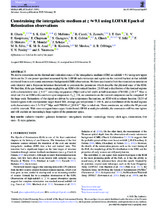Constraining the intergalactic medium at z ≈ 9.1 using LOFAR Epoch of Reionization observations
Abstract
We derive constraints on the thermal and ionization states of the intergalactic medium (IGM) at redshift ≈ 9.1 using new upper
limits on the 21-cm power spectrum measured by the LOFAR radio telescope and a prior on the ionized fraction at that redshift
estimated from recent cosmic microwave background (CMB) observations. We have used results from the reionization simulation
code GRIZZLY and a Bayesian inference framework to constrain the parameters which describe the physical state of the IGM.
We find that, if the gas heating remains negligible, an IGM with ionized fraction 0.13 and a distribution of the ionized regions
with a characteristic size 8 h−1 comoving megaparsec (Mpc) and a full width at half-maximum (FWHM) 16 h−1 Mpc is
ruled out. For an IGM with a uniform spin temperature TS 3 K, no constraints on the ionized component can be computed. If
the large-scale fluctuations of the signal are driven by spin temperature fluctuations, an IGM with a volume fraction 0.34 of
heated regions with a temperature larger than CMB, average gas temperature 7–160 K, and a distribution of the heated regions
with characteristic size 3.5–70 h−1 Mpc and FWHM of 110 h−1 Mpc is ruled out. These constraints are within the 95 per cent
credible intervals. With more stringent future upper limits from LOFAR at multiple redshifts, the constraints will become tighter
and will exclude an increasingly large region of the parameter space.

